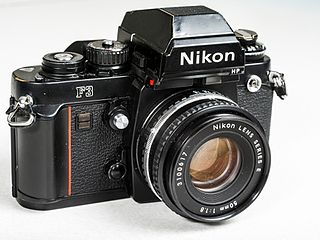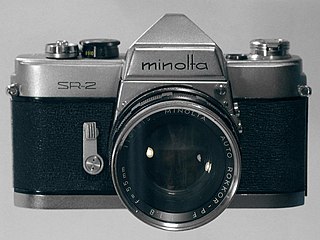
A single-lens reflex camera (SLR) is a camera that typically uses a mirror and prism system that permits the photographer to view through the lens and see exactly what will be captured. With twin lens reflex and rangefinder cameras, the viewed image could be significantly different from the final image. When the shutter button is pressed on most SLRs, the mirror flips out of the light path, allowing light to pass through to the light receptor and the image to be captured.

A twin-lens reflex camera (TLR) is a type of camera with two objective lenses of the same focal length. One of the lenses is the photographic objective or "taking lens", while the other is used for the viewfinder system, which is usually viewed from above at waist level.

The Nikon F camera, introduced in April 1959, was Nikon's first SLR camera. It was one of the most advanced cameras of its day. Although many of the concepts had already been introduced elsewhere, it was revolutionary in that it was the first to combine them all in one camera. It was produced until October 1973 and was replaced by the Nikon F2. Aspects of its design remain in all of Nikon's subsequent SLR cameras, through the current Nikon F6 film and Nikon D6 digital models. The "F" in Nikon F was selected from the term "re-f-lex", since the pronunciation of the first letter "R" is not available in many Asian languages. That tradition was carried all the way through their top line of Nikon cameras until the introduction of the Nikon D1 (digital) cameras decades later.

Minolta Co., Ltd. was a Japanese manufacturer of cameras, camera accessories, photocopiers, fax machines, and laser printers. Minolta Co., Ltd., which is also known simply as Minolta, was founded in Osaka, Japan, in 1928 as Nichi-Doku Shashinki Shōten. It made the first integrated autofocus 35 mm SLR camera system. In 1931, the company adopted its final name, an acronym for "Mechanism, Instruments, Optics, and Lenses by Tashima".
Kiev is a Soviet and Ukrainian brand of photographic equipment including cameras manufactured by the Arsenal Factory in Kyiv, Ukraine. The camera nameplates show the name "KIEV", with older cameras using "КИЕВ" or "КИЇВ" in Cyrillic.

Contax began as a German camera model in the Zeiss Ikon line in 1932, and later became a brand name. The early cameras were among the finest in the world, typically featuring high quality Zeiss interchangeable lenses. The final products under the Contax name were a line of 35 mm, medium format, and digital cameras engineered and manufactured by Japanese multinational Kyocera, and featuring modern Zeiss optics. In 2005, Kyocera announced that it would no longer produce Contax cameras. The rights to the brand are currently part of Carl Zeiss AG, but no Contax cameras are currently in production, and the brand is considered dormant.

The Nikon F3 is Nikon's third professional single-lens reflex camera body, preceded by the F and F2. Introduced in March 1980, it has manual and semi-automatic exposure control whereby the camera would select the correct shutter speed. The Nikon F3 series cameras has the most model variations of any Nikon F camera. It is also the first of numerous Nikon F-series cameras to be styled by Italian designer Giorgetto Giugiaro, and to include a red stripe on the handgrip – a feature that would later become a signature feature of many Nikon cameras.

The history of the single-lens reflex camera (SLR) begins with the use of a reflex mirror in a camera obscura described in 1676, but it took a long time for the design to succeed for photographic cameras. The first patent was granted in 1861, and the first cameras were produced in 1884, but while elegantly simple in concept, they were very complex in practice. One by one these complexities were overcome as optical and mechanical technology advanced, and in the 1960s the SLR camera became the preferred design for many high-end camera formats.
Rectaflex was the world's first series produced Pentaprism single lens reflex camera. It was produced from 1948 to 1958. Rectaflex was the only Italian single-lens reflex camera ever built.

The Canon Pellix is a manual-focus single-lens reflex (SLR) camera released in 1965 that uses a stationary half-silvered mirror behind which a metering cell is raised during light level metering.

The Contaflex series is a family of 35mm Single-lens reflex cameras (SLR) equipped with a leaf shutter, produced by Zeiss Ikon in the 1950s and 1960s. The name was first used by Zeiss Ikon in 1935 for a 35mm Twin-lens reflex camera, the Contaflex TLR; for the earlier TLR, the -flex suffix referred to the integral reflex mirror for the viewfinder. The first SLR models, the Contaflex I and II have fixed lenses, while the later models have interchangeable lenses; eventually the Contaflexes became a camera system with a wide variety of accessories.

The Auto-Reflex and Autoreflex is a series of 35mm SLR cameras made by Konica from 1965 to 1988. All these models have the Konica AR bayonet.

The Pentax MG is an entry-level, interchangeable lens, 35mm film, single-lens reflex (SLR) camera manufactured by Asahi Optical Co., Ltd. from 1981 to 1985. It was introduced as the successor to the Pentax MV and MV1 cameras.

The Kodak Retina Reflex is a discontinued series of four single-lens reflex cameras made by Kodak in Germany between 1957 and 1974, as part of the Kodak Retina line of 35mm film cameras.
This article discusses the cameras – mainly 35 mm SLRs – manufactured by Pentax Ricoh Imaging Corp. and its predecessors, Pentax Corporation and Asahi Optical Co., Ltd.. Pentax must not be confused with Pentax 6x7 or Pentax 67 which are 120 medium format 6x7cm film cameras.

The Mecaflex is a 35mm SLR camera for 50 exposures of 24 × 24 mm. It was presented at the photokina in Cologne in 1951, and launched commercially about two years later. The design is by Heinz Kilfitt, who is also known for designing the original Robot camera and the Kowa Six.

The Topcon RE Super, or Beseler Topcon Super D in USA, was launched by Tokyo Kogaku KK in 1963 and manufactured until 1971, at which point it was upgraded to the Super D and again to Super DM the following year. General sale continued for several years. These later models have a shutter release lock lever on the shutter release collar. It is a professional oriented 35mm SLR camera that had a comprehensive range of accessories available. It has a removable pentaprism viewfinder and focusing screen. It features the Exakta bayonet lens mount for interchangeable lenses. A special accessory shoe is situated at the base of the rewind knob with a standard PC sync. contact next to it. The release button is placed at the right-hand camera front, but there is no mirror-up facility; this was included on the upgraded versions. The standard lens is the RE. Auto-Topcor 1:1.4 f=5.8cm or the slightly slower 1:1.8 version. A battery-operated winder could be attached to the camera base.

The Minolta SR-2 was presented in 1958 as the first 35mm SLR camera from Chiyoda Kogaku. Popular cameras of this type at that time were mainly from Europe but a few from Japan, including the Asahi Pentax, the Miranda T and the Topcon R. The miniature SLR camera concept was conceived in the 1930s at Ihagee in Dresden, resulting in the 1936 Kine Exakta. Influential cameras designs like that of the 1939 KW Praktiflex, the 1949 ZI Contax S, and 1952 the KW Praktina marked the steady progress toward a perfected SLR. Several features of the latter seem to have influenced the design of the SR-2 although dissimilar in many respects. The obvious similarities are the stepped top plate, the carrying strap lugs, the self-timer lever and some general body features.

The Kine Exakta was the first 35mm single-lens reflex (SLR) still camera in regular production. It was presented by Ihagee Kamerawerk Steenbergen GmbH, Dresden at the Leipziger Frühjahrsmesse in March 1936. The Exakta name had already been used by Ihagee on a roll film rangefinder RF camera line since 1933, among these the Vest Pocket Exakta Model B from which the Kine Exakta inherited its general layout and appearance. The word Kine never appeared on the camera itself, only in the instruction manuals and advertising to distinguish it from the roll film variants. Several of its features constituted the foundation for the majority of 35mm SLR cameras produced ever since, although at this stage in a relatively primitive state.

Kamera-Werkstätten Guthe & Thorsch (K.W.) was established 1919 in Dresden by Paul Guthe and Benno Thorsch, starting out manufacturing the Patent Etui plate camera. Ten years later came the roll film TLR Pilot Reflex and in 1936, the 6×6 SLR Pilot range. By that time, Benno Thorsch, the surviving partner from 1919, decided to immigrate to the United States and arranged with the US citizen Charles Noble to swap enterprises. Noble came to Germany and moved the factory to Niedersedlitz on the outskirts of Dresden, while Benno Thorsch in Detroit ran the acquired photo finishing business that was one of the largest in the USA. The new Kamera-Werkstätten AG, Niedersedlitz prospered, and in 1939 launched the 35mm SLR Praktiflex camera. The concept proved successful, and through continuous development, the Praktica name became one of the most popular 35mm SLR brands for several decades, beginning in the 1950s.


















